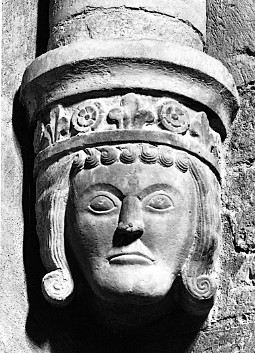
Magnus Ladulås or Magnus Birgersson,, was King of Sweden from 1275 until his death in 1290.

Birger Jarl, also known as Birger Magnusson, was a Swedish statesman and regent, jarl, and a member of the House of Bjelbo, who played a pivotal role in the consolidation of Sweden. His first marriage was to Princess Ingeborg of Sweden, which created his base of power. Birger led the Second Swedish Crusade, which established Swedish rule in Finland. Additionally, he is traditionally attributed with the foundation of the Swedish capital, Stockholm, around 1250. Birger used the Latin title of Dux Sweorum, and the design of his coronet combined those used by continental European and English dukes.

Eric XI Ericsson or Eric the Lisp and Lame was King of Sweden from 1222 to 1229 and again from 1234 to 1250. Being the last ruler of the House of Eric, he stood in the shadow of a succession of powerful Jarls, especially his brother-in-law Birger Jarl, whose descendants ruled as kings after his death.

John I was King of Sweden from 1216 until his death in 1222.

Eric X was King of Sweden between 1208 and 1216. Also known as Eric the Survivor, he was, at his accession to the throne, the only remaining son of King Canute I of Sweden and his queen. The name of his mother is not known, but may have been Cecilia.
Sverker II or Sverker the Younger was King of Sweden from 1195 or 1196 to 1208 when he was defeated in the Battle of Lena by Prince Eric. Sverker died in the 1210 Battle of Gestilren where his forces battled those of King Eric X.

Canute I was king of Sweden from 1173 to 1195. He was a son of King Eric the Saint and Queen Christina, who was a granddaughter of the Swedish king Inge the Elder.

The Battle of Gestilren took place on July 17, 1210. The battle was fought between the exiled King of Sweden Sverker and the ruling King Eric X. Sverker had been beaten in the previous Battle of Lena, but returned with new forces. Sverker was however killed in the battle. The exact strength of the armies is unknown.

Birger Brosa Old Norse: Birgir Brósa was jarl of Sweden from 1174 to 1202.

Bjälbo is a small village in Mjölby Municipality, Östergötland, Sweden.
Magnus Minniskiöld was a medieval Swedish magnate from the House of Bjelbo. He is best known as the father of the renowned statesman Birger Jarl, and the ancestor of the later Swedish kings. He is sometimes believed to have perished in the Battle of Lena in 1208, though the evidence is not conclusive.

Bishop Benedict, Duke of Finland was a Swedish prelate bishop and duke.
Ulf Fase was the jarl of Sweden.

Karl the Deaf from the House of Bjelbo (Folkungaätten) was the jarl of Sweden during 1216–1220.
Bengt Snivil from the House of Bjelbo was a Swedish magnate in mid-12th century.
Knut Birgersson was Riksjarl of Sweden. He was the eldest surviving son of Riksjarl Birger Brosa and a member of the powerful House of Bjälbo also known as the House of Folkung (Folkungaätten).
Jarl is a rank of the nobility in Scandinavia. In Old Norse, it meant "chieftain", particularly a chieftain set to rule a territory in a king's stead. Jarl could also mean a sovereign prince. For example, the rulers of several of the petty kingdoms of Norway had the title of jarl and in many cases they had no less power than their neighbours who had the title of king. It became obsolete in the Middle Ages and was replaced by duke (hertig/hertug/hertog). The word is etymologically related to the English earl.
IngegerdBirgersdotter of Bjelbo was Queen of Sweden as the second wife of King Sverker II.

Bridget Haraldsdotter, also Brigida was Queen of Sweden as the spouse of King Magnus II.

The Battle of Sparrsätra was fought in 1247 between the forces of King Eric XI of Sweden and rebels led by Holmger Knutsson near Enköping in Sweden. It occurred during a poorly documented period in Swedish history; as a result, many details are uncertain and conjectural.













